Artillery raids
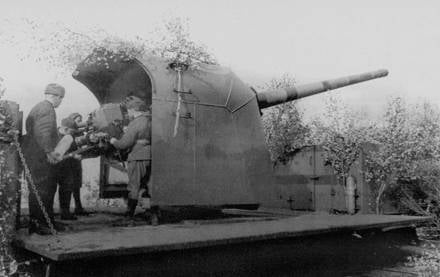
Why did our railway artillery (ZhDAU) operate so successfully? Yes, because our ZhDAU worked as special forces or even as terrorists. No, I'm not joking! Remember Shamil Basayev: “raid - waste, raid - waste”?
The exit position, quick and accurate hit and instant withdrawal. In this case, the complete disguise before the strike, during the strike and after the strike.
Railway installations near Leningrad were not similar to artillery transporters in reference books or museums. They rather resembled thickets of bushes - a bunch of branches and camouflage nets. The plant produces a 356 – 180 caliber projectile mm and leaves in half a minute. “Yes in what half a minute? - the historian will be indignant. “After all, according to the instruction to move the ZhDAU from the combat to the marching position, 30 (!) Minutes is laid.”
Well, who cares about instruction, and who cares about life. Commanders and fighters simply ignored all instructions. So, the sites were not cleaned, the mount was mounted at the exit from the firing positions, the longitudinal bars were tipped off to the side, and the supporting cushions were left in place. Departure from a position at a distance of 400 – 500 m was accomplished under its own power and at low speeds, with loose supporting legs. Subsequently, the supporting legs ceased to throw on the carts, but only lifted on 20 – 30 cm from the rail head.
Of course, the splayed “legs” of the ZhDAU could demolish the switchman’s house or the dacha platform, they would have caused a train wreck on an oncoming lane. But all the buildings have long been demolished, oncoming trains could not be physically. Sometimes the first shots were fired with all three battery guns of “false positions” that the Germans could detect after they started shooting, and then they left immediately.
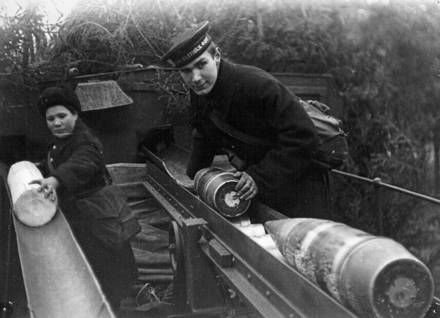
However, a different method was used more often. Gun No. 1 fired and began to withdraw to a new position at a distance of 100 – 200 meters. Then shot the gun number 2 and also began to withdraw. Well, when, after the shot, the gun number 3, lifting a few centimeters above the ground "legs", began to withdraw, fired gun number 1, which has already taken a new position.
In order to prevent enemy’s sound stations and optical equipment from detecting the shooting of 356 – 180 mm rail transporters, the X-NUMX-mm A-122 and 19-mm howitzer ML-152 cannon opened fire with them. Sometimes railway installations of caliber 20 – 130 mm were also involved. In addition, explosives, imitating heavy guns, were actively used.
Of course, the Germans were not fools, and if in 1941 - the beginning of 1942 they started firing in 20 – 25 minutes after opening fire with our transporters, then this gap was reduced to 7 – 8 minutes. I note that the Germans and the Finns had very sophisticated sound and visual reconnaissance devices and exchanged information in real time.
However, they failed to find our transporters in time. So, for example, the 19-th battery of the 180-mm units until October 1943 held the 118 outputs and in 89 cases was subjected to a response fire effect. The Germans fired on the battery to 1500 shells caliber 150 – 240 mm. However, no conveyor was incapacitated.
What were railway installations? I'll start with the fact that railway installations are like real weapon appeared only during the First World War. By 1918, the French artillery had more than 500 rail installations of caliber 200 – 400 mm. A Russian artillery had two (!) 254-mm units, and even that failed design.
About the French, I mentioned for good reason. Over a hundred French heavy rail installations in the summer of 1940, the Germans became trophies and were used by the Wehrmacht on all fronts from the Atlantic Wall and Norway to Leningrad and Sevastopol.
German ZhDAU successfully acted during the First World War, but were all destroyed in 1919 – 1920 under the terms of the Versailles Treaty. And henceforth the Germans were forbidden to have such a formidable weapon. However, the Germans in 1930 – 1941 created several dozen IDAUs in the 21 – 80 caliber.
Under Leningrad in 1941 – 1944, they met in the most grandiose artillery battle in stories humanity's best heavy domestic, German and French rail installations. Of these, the most powerful were 52-cm French railway howitzers, which threw shells weighing 2 tons into the city.
Soviet artillery near Leningrad was represented by battery No. 11 (3 – 356-mm transporter TM-1 – 14) and three 180-mm train batteries No. 12, 18 and 19, each with four TM-1 – 180 transporters.
In addition, in 1941 – 1942, Leningrad’s plants, primarily the Bolshevik (Obukhovsky) plant, installed four 152 / 57-mm, thirty-six 130 / 50-mm, four 120 / 50-mm and two 100-mm ship cannons.
The difference in the subordination of the Soviet and German railway installations is curious. The Germans before the war and in the course of its over 90% ZhDAU obeyed the Wehrmacht, among them were all ZhDAU, who fired at Leningrad. Kriegsmarine obeyed several installations of the Atlantic Wall.
In the USSR since 1921, all railway installations were part of the Naval Forces. In the summer and autumn of 1941, new installations of 100–152 mm caliber received from the factories, the command of the Leningrad Front haphazardly transferred to the Baltic the fleet, and individual land units. For example, batteries No. 41 and No. 42, each armed with two 152/57-mm B-38 guns, were transferred to the army and included in the Nevsky fortified sector. All batteries had double-digit numbers. The land commanders did not understand either naval guns or railway transporters, the army did not have ammunition for these guns, and in the end it was decided to concentrate all the railway artillery under a single command.
8 January 1942 was formed 101-I naval railway artillery brigade consisting of seven separate divisions, 11-i separate battery and armored train № 30. The brigade was assigned the tasks of counter-battery struggle with the German artillery firing at the city, fire support for the advancing troops of the Leningrad Front, and the provision of maritime communications Leningrad-Kronstadt.
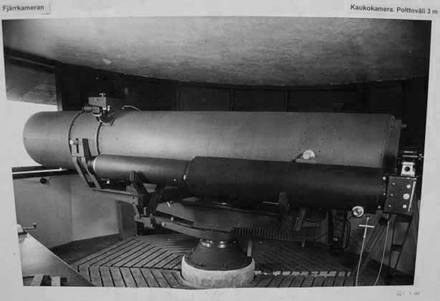
The brigade included 16 two-gun 130-mm batteries, which until January 1942 were transferred to the armies of the Leningrad Front, and 12 batteries from the Baltic Fleet. The 101-I naval brigade of railway artillery was subordinated to the commander of the Leningrad naval base.
I note that in 1942 – 1945. several times the army authorities took demarches, ranging from the level of command of the front, up to and including the State Defense Committee, demanding that the IDAU be subordinated to the army. Nevertheless, all the WAU remained with the sailors.
Without exaggeration, it can be said that the ZhDAU became literally the fiery sword of the defenders of Leningrad during all the 35 months of the siege. And this is due not so much to the number of railway artillery barrels, but to a number of subjective reasons. So the admirals took care of the trunks and mechanisms of the guns of the main caliber of battleships, cruisers and forts of Kronstadt. Well, ZhDAU were consumables. So, the author contradicts himself, arguing that not a single railway installation died?
Yes, it did not die from the impact of the enemy. But the trunks were worn out from the often almost daily fire, the recoil devices, locks, lifting mechanisms, etc., failed. But then Leningrad Bolshevik, Kirovsky and Arsenal factories (the Frunze plant) came to the rescue.
Thus, according to reports of the Bolshevik plant, during the blockade, over 3 thousand (!) Bodies of naval guns and 20 thousand medium and large caliber shells were manufactured. Well, let's say, the liners were also included in the reports along with the trunks. But the difference is in cost, not in vitality.
The Germans knew about the activities of the Bolshevik and at the beginning of 1942 of the year they installed 10 long-range stationary batteries in the Fedorovskoye - Antropshino area specifically for the destruction of the Bolshevik's shops. In addition, on the Novo-Liseno-Pavlovsk line, German rail installations regularly cruised, which also shelled the plant. And they, in turn, were suppressed by our ZhDAU along with stationary marine batteries and guns of ships stationed on the Neva. An ideal example of mutual assistance of the rear and front.
In addition to counter-battery shooting and other tasks, the ZhDAU near Leningrad was engaged in hunting for German ... planes! Of course, this is not about anti-aircraft fire, but about regular shelling of German airfields, which are located up to 40 km from the front line.
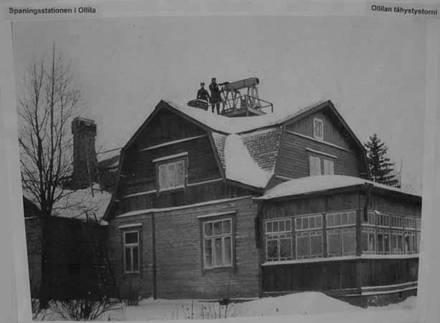
During the war years, the Germans called our light night bombers U-2 "lame crows", "nerve saw", etc. However, they themselves at the beginning of 1943 created several similar squadrons as part of the 1 air fleet . They were consolidated into a light bombing group (Stoerkampfgruppe Luftflotte 1). The materiel of the new group consisted of obsolete light bombers and training aircraft taken from various Luftwaffe flight schools. The “Nightlights” of the Stoerkampfgruppe flew on a very heterogeneous “collection” consisting of various biplanes, such as Ar-66, Go-145, He-45, He-46 and W.34. In order to use these light machines, which had a small radius of action with great effect, they had to be located as close as possible to the front line. Therefore, it is quite natural that the group was placed at the advanced airfield in Gatchina.
It is curious that the biggest losses of the new air group suffered on 9 on April 1943 of April, as a result of ... the non-shooting of our gunners. I quote the “Chronicle of the Great Patriotic War of the Soviet Union on the Baltic Sea and Lake Ladoga”: “One railway battery transporter No. 19 (180-mm) from 1 h. 10 m. To 1 h. 18 m. And from 4 h. 30 m. until 4 h. 37 m. led artillery fire on the station Gatchina-Commodity, causing fires and explosions there. Covering this shooting, the second battery transporter No. 19 at the same time fired at the enemy battery near the village of Novaya. ”
Several 180-mm shells fell on the airfield of the Gatchina airfield, causing eight He-46 and four Ar-66 to be burned. This was noticed by Soviet intelligence, and already 10 of April is one railway battery transporter No. 19 with 4 h. 10 min. to 4 h. 16 min. led artillery fire at the Gatchina airfield. Covering this shooting, the second conveyor of the same battery with 4 h. 10 min. to 4 h. 30 min. shot at the area of the city of Krasnoye Selo.
After that, shelling of the Gatchina airfield began to be conducted almost daily. 12 April one railway battery transporter No. 19 with 1 h. 30 min. to 1 h. 35 min. and with 4 h. 35 min. to 4 h. 42 min. fired at this airfield. Providing shooting, the second battery transporter No. 19 with 1 h. 30 min. to 5 h. 05 min. fired on German batteries in the area of Krasnoye Selo - Novoe.
The next night it was the same. At the airport was seen a big fire.
A few words should be said about the two TM-1 – 180 railway transporters transported on barges in November 1942 from Leningrad to Kronstadt. There they were put on stationary positions in the western part of Kotlin Island near the old fort Alexander-Shanets (Shants), from where they could act on Finnish positions. Of these two 180-mm guns, a rail battery no. 19 a was formed. True, now the railroad was only in name, and in fact was a stationary battery. The two TM-1 – 180 transporters that remained in Leningrad were still considered battery No. 19.
Battery number 19 and periodically suppressed long-range batteries of the Finns. So, 8 April 1943 r. Battery No. 19 and from 17 h. 00 min. to 18 h. 45 min. three times fired at the suppression of the enemy battery, at the same time 130-mm battery No. 130 from Fort Komsomolsky (“Reef”), covering the fire of the battery No. 19 a, fired at the station Tyurisivya and Ino.
19 May Railway Battery Transporter No. 19 a with 22 h. 59 min. to 23 h. 41 min. suppressed Finnish batteries located in the Alipumala area.
5 June even the main caliber of the fort "Krasnaya Gorka" was attracted to fight the Finnish batteries. 305-mm battery No. 311, 130-mm batteries No. 211 and 319 of the Izhora strengthened sector, and 180-mm battery No. 19 a, 152-mm battery No. 121 and 130-mm battery of the Kronstadt fortified sector with 15 ch. to 00 h. 15 min. made a raid on the Finnish batteries located in the areas of Vohnal, Vitikkala and Kuokkala.
Then one wonders the question: why do our railway and stationary guns fired so many shells on Finnish batteries? After all, according to the claims of our liberal historians, Finnish guns never fired at Leningrad. Holy truth! Only Germans fired at Nevsky Prospect and the Kirov Plant. But on Lisie Nos, Kotlin Island, Olgino districts, Old Village, etc. Finns beat them. Finnish shells flew to the Finland Station.
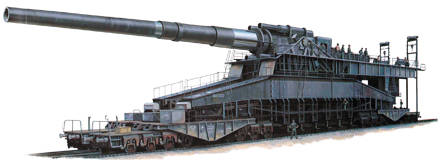
For the shelling of Leningrad, the Finns used two X-NUMX-mm rail installations TM-180 – 1 (barrel numbers 180 and 86), captured in the summer of 102, on the Karelian Isthmus.
Since November 1941, the Finnish 180-mm railway installations from the regions of Kuokkala and Ollila fired on unknown targets several times - Kronstadt, Leningrad? Post-war Finnish historians claim that their rail installations received orders to shoot the battleship Marat. But the trouble is that they didn’t notice it on the battleship.
After the war, Finnish historians claim that Finnish guns fired only at the forts of Kronstadt. But in most cases in our secret sources there is no evidence of this. That is, completely different targets were fired in the city.
In addition to the railway installations in the village of Kellomäki (now Komarovo), the Finns in December 1941 organized a secret battery 254 / 45-mm guns of the Obukhov plant system. The 235-kg projectile firing range was 29,5 km.
From Kellomäki 10-inch guns could fire all Kotlin, all the forts of the Kronstadt fortress and the north-western outskirts of Leningrad.
Finally, in 1943, the Finns put into operation three 305-mm rail transporters TM-1 – 12 captured at Hanko. By the end of the summer, 1943 was used to form the 3-th Railway Battery. It is curious that for them the Finns produced ultra-long 320-kg shells, which at the initial speed of 950 m / s could fly to the range 50 – 52 km. Such projectiles could hit not only the eastern outskirts of Leningrad and NIMAP, but even reach Kolpino. The rhetorical question: why did the Finns need such projectiles?
A weighty volume can be written about the actions of the Soviet railway artillery near Leningrad. But here it is necessary to confine brief information.
By the end of the war, there were three 356-mm, three 305-mm, twelve 180-mm, twelve 152-mm and thirty-nine 130-mm units in the railway artillery brigade, which is significantly more than before the war.
During the war years, 109 artillery batteries and individual guns were destroyed by the railway artillery brigade, 84 were destroyed tank, 335 cars, one railway train, 12 bunkers were destroyed, 4 railway bridges were destroyed. During the blockade of the Baltic ports, 130 small rail vehicles sank 5 small transports and 36 boats and barges.
Since I would not like to be accused of fooling the enemy, I will give an example of competent disguise and observance of a number of measures of secrecy when firing at Sevastopol the world's largest gun - Dora 80-cm.
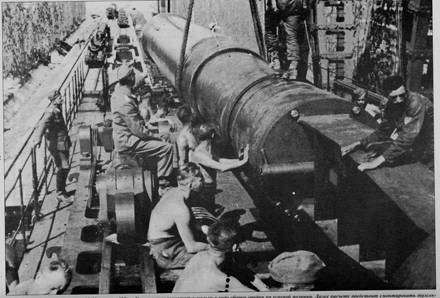
In February 1942, General Halder, the Chief of the Ground Forces General Staff, ordered the Douro to be sent to the Crimea and transferred to the 11 Army Commander to reinforce the siege artillery.
25 April 1942. Echelons with a dismantled artillery installation secretly arrived at the Tashlykh-Dair station (now the village of Yantnoe, Krasnogvardeysky district) in 30 km south of the railway junction Dzhankoy, where they were carefully masked by regular means.
The position for “Dora” was chosen in 25 km from the location of the targets intended for the shelling within the borders of СОРа (mainly on the North side) and in 2 km south of the Bakhchisarai railway station.
A special feature of the position was its construction in an open field, on a plot where there was neither a difficult relief, nor rock shelters, nor even a small fishing line. A completely bare marl hill between the Churuk-Su river and the Bakhchisarai-Sevastopol railway was opened by a longitudinal dredging depth of 10 m and a width of about 200 m in the direction of the north-east-south-west. A kilometer line was laid east of the hill to Bakhchisarai station, and “mustaches” were laid to the west of the hill, which provided a horizontal angle of attack at 45 °.
At the site of supplying the artillery system to the excavation and directly in it, the tracks were built with two- and three-track ones for moving the erection cranes, and during firing - for parallel placement of two transport-charging cars with projectiles and charges.
Work on the construction of the firing position were carried out for four weeks. 600 military construction workers, the Trudfront workers of the Todt organization, 1000 people of local residents and a number of prisoners of war captured by the Germans during the breakthrough of the Perekop positions and the capture of Kerch in October-November 1500 were attracted. The works were carried out around the clock. Security was ensured by a reliable camouflage and constant patrols over the area of fighters from the 1941-th Air Corps of General Richthofen. Next to the position, a battery of 8-cm anti-aircraft guns and a battery of 8,8-cm anti-aircraft guns were built.
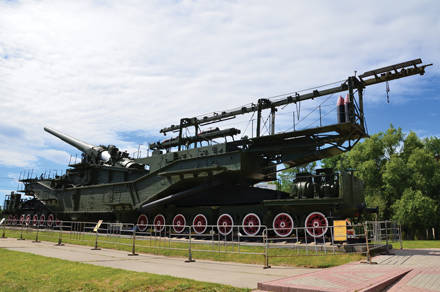
In addition, the Douro was served by a smoke screening division, two Romanian infantry guard companies, a squad of service dogs and a special motorized field gendarmerie team. Computing groups in the battery made all the necessary calculations for firing, and a platoon of artillery observers used, along with traditional means, infrared technology. In total, the combat activity of the gun was provided by more than four thousand people.
The entire district was declared a forbidden zone by the occupying administration and the Gestapo, with all the ensuing consequences for wartime.
As a result, neither the underground workers, nor the partisans, nor the naval and army intelligence services, nor the NKVD bodies, until the end of the defense of Sevastopol, really could learn anything about the "Dora". True, there were rumors among the population about the German Tsar Cannon with the most ridiculous details.
For the first time, “Dora” fired a 7,1-ton 5 June 1942 projectile around Sevastopol. To disguise the shooting of “Dora”, three German 28-cm railway installations were firing simultaneously with it, based on the Shakul station (now Samokhvalovo) in 7 km north of Bakhchisarai station.
The command of the SOR and could not understand who fired at Sevastopol. In intelligence reports there was information about 240-mm and 24-inch (610-mm) railway installations, etc.
After the end of the fighting in the Crimea in May 1944, a special commission was engaged in the search for the firing position of a super-heavy weapon in the areas of the villages of Duvanka (now Verkhsadovoye) and Zalanka (Front), but without success. Documents on the use of "Dora" also was not among the trophies of the Red Army captured in Germany. Therefore, a number of official historians concluded that there was no “Dora” near Sevastopol at all, and all the rumors about it were the “disinformation” of the Abwehr.
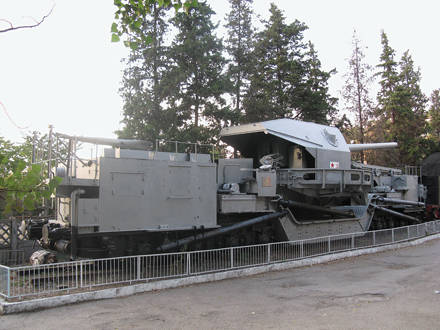
But in the 1980-ies in the USSR, historians appeared, claiming that "Dora" did not shoot at Sevastopol, but at Stalingrad. A source of these conclusions was the fire barrel. The fact is that in 1945, our troops in Thuringia captured the “Douro”, and then delivered it to the Rzhevsky training ground near Leningrad. In 1950, the Douro was transported to Stalingrad at the Barricades factory for review.
In June, 1959, the deputy. Chairman of the Council of Ministers? D. F. Ustinov ordered to hand over “Dora” for scrap. And one of the seven shells of the Dora was used at the factory as a fire tank, and later it was sent to Malakhov Kurgan as a trophy. And then zealous guys began to write stories about the shooting of “Dora” at Stalingrad.
Information